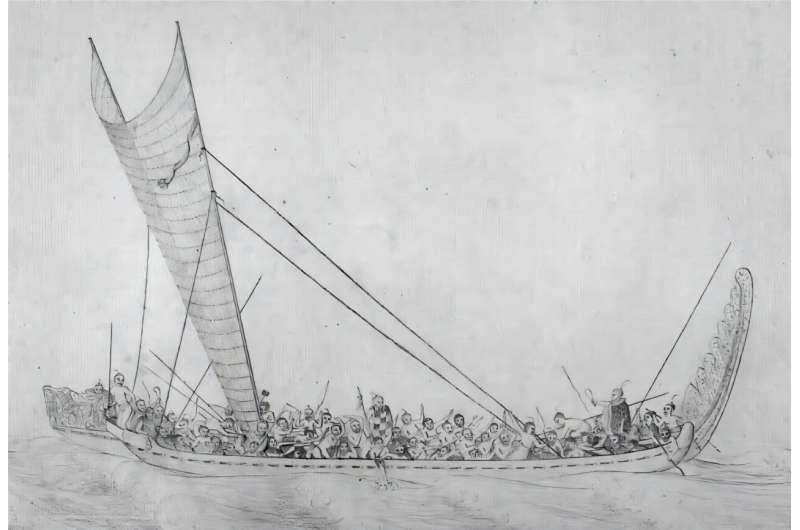Science
Archaeologists Investigate Indigenous Voyaging Below 50°S

Archaeologists have conducted a detailed study examining the potential for Indigenous long-distance voyaging below the 50th parallel in the Southern Hemisphere. In a paper published in the *Journal of Coastal and Island Archaeology*, a research team led by Dr. Thomas Leppard along with John Cherry and Atholl Anderson, analyzed existing evidence to assess whether such voyages occurred prior to European contact.
The researchers concluded that there is no indication that Indigenous peoples undertook these voyages before the arrival of Europeans. They attribute this to the significant environmental challenges and impracticalities associated with navigating the treacherous Southern Ocean, rather than a deficiency in seafaring skills.
Challenges of the Southern Ocean
The Southern Ocean, located south of the 50th parallel, presents formidable conditions, including powerful winds, immense ice sheets, and severe cold. Many islands within this region are inhospitable, characterized by barren landscapes that support only a limited range of wildlife, such as seals and seabirds. Previously, it was widely believed that these islands, with the exception of Tierra del Fuego in South America, remained uninhabited before European exploration.
Recent claims suggesting that Indigenous peoples may have known of and even settled on these islands challenge this notion. If substantiated, such findings could transform our understanding of Indigenous maritime capabilities, potentially categorizing long-distance voyaging below the 50th parallel as a historical norm.
Among the Indigenous peoples, the Māori of New Zealand are recognized as exceptional navigators, known for their extensive seafaring traditions. Additionally, a Rarotongan oral tradition recounts the tale of navigator Ui-te-Rangiora, who allegedly ventured to Antarctica. However, this account is complicated by the absence of a pre-European Rarotongan word for ice, leading to questions regarding the accuracy of these historical narratives.
Evidence from Island Settlements
The research team scrutinized evidence from islands located south of the 50th parallel, particularly focusing on signs of human occupation. Notably, Enderby Island, part of the Auckland Islands, was settled by the Māori around 1300–1400 AD, but later abandoned due to adverse climate conditions. Despite Enderby Island’s habitation, the team found no evidence of human presence on southern islands, which likely face even harsher living conditions.
Dr. Leppard speculates that the extreme environment of Enderby Island, with average temperatures around 8°C and 300 rainy days annually, would render habitation further south unviable. The absence of wood necessary for ship repairs and limited access to vital resources such as flax, which would need to be sourced from New Zealand, further complicates the feasibility of such extensive voyages.
The researchers highlighted the lack of oral traditions or historical accounts from other Indigenous groups in Australia or southern South America that would support the existence of long-distance maritime practices. Dr. Leppard stated, “We have not found any other oral histories of southern voyaging and we would not expect them because no offshore seafaring technology comparable to that in Polynesia was recorded in Australia or southern South America.”
Archaeological investigations into potential South American settlements on islands like the Falkland Islands and others in the South Atlantic yielded limited results. While some artifacts, including stone tools linked to Indigenous peoples, have been discovered, these are all associated with post-European contact activities, such as the transfer of 150 Fuegians to Pebble Island in 1855.
The study emphasizes that the maritime technology available to pre-contact Indigenous peoples in southern South America was primarily suited for navigating inland waterways, utilizing small vessels that were ill-equipped for the open ocean.
Dr. Leppard noted the implications of the lack of archaeological evidence, stating, “In these environments, we would actually expect organic materials to preserve better. Cold conditions inhibit decay, while warmer conditions exacerbate it.” This absence raises significant doubts about the occurrence of long-distance voyages prior to European arrival.
Although the researchers concluded that the risks associated with such voyages likely deterred Indigenous peoples from attempting them, they encourage further investigation and data collection to potentially reassess their findings. Dr. Leppard remarked, “While we’re not planning another collaborative paper on the Antarctic in the near future, we look forward to continuing to work on issues of colonization, seagoing, and island adaptations.”
This research enriches the ongoing dialogue surrounding Indigenous navigation and settlement patterns in extreme environments and underscores the importance of rigorous archaeological inquiry into historical maritime practices.
-

 Lifestyle4 months ago
Lifestyle4 months agoLibraries Challenge Rising E-Book Costs Amid Growing Demand
-

 Sports3 months ago
Sports3 months agoTyreek Hill Responds to Tua Tagovailoa’s Comments on Team Dynamics
-

 Sports3 months ago
Sports3 months agoLiverpool Secures Agreement to Sign Young Striker Will Wright
-

 Lifestyle3 months ago
Lifestyle3 months agoSave Your Split Tomatoes: Expert Tips for Gardeners
-

 Lifestyle3 months ago
Lifestyle3 months agoPrincess Beatrice’s Daughter Athena Joins Siblings at London Parade
-

 World3 months ago
World3 months agoWinter Storms Lash New South Wales with Snow, Flood Risks
-

 Science4 months ago
Science4 months agoTrump Administration Moves to Repeal Key Climate Regulation
-

 Science2 months ago
Science2 months agoSan Francisco Hosts Unique Contest to Identify “Performative Males”
-

 Business4 months ago
Business4 months agoSoFi Technologies Shares Slip 2% Following Insider Stock Sale
-

 Science4 months ago
Science4 months agoNew Tool Reveals Link Between Horse Coat Condition and Parasites
-

 Sports3 months ago
Sports3 months agoElon Musk Sculpture Travels From Utah to Yosemite National Park
-

 Science4 months ago
Science4 months agoNew Study Confirms Humans Transported Stonehenge Bluestones









